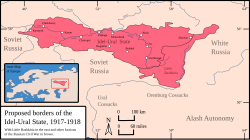This article needs additional citations for verification. (July 2020) |
Idel-Ural State ادیل-اورال Идел-Урал | |||||||||||||||
|---|---|---|---|---|---|---|---|---|---|---|---|---|---|---|---|
| 1–28 March 1918 | |||||||||||||||
|
Flag | |||||||||||||||
 Claimed borders of Idel-Ural | |||||||||||||||
| Capital | Ufa | ||||||||||||||
| Common languages | Tatar, Russian | ||||||||||||||
| Government | Republic[1] | ||||||||||||||
| President | |||||||||||||||
• 1918 | Sadrí Maqsudí Arsal[2] | ||||||||||||||
| Historical era | Russian Civil War | ||||||||||||||
• Proclamation | 1 March 1918 | ||||||||||||||
• Government in-exile | 1918 | ||||||||||||||
• Defeat by Red Army | 28 March 1918 | ||||||||||||||
| |||||||||||||||
| History of Tatarstan |
|---|
 |
The Idel-Ural State (Tatar: Идел-Урал өлкәсе,[citation needed] İdel-Ural ölkäse, ادیل-اورال اولكسی, also İdel-Ural berlege İdel-Ural ştatı), also known as the Volga-Ural State or Idel-Ural Republic,[3] was an unsuccessful attempt of the autonomy of Tatar peoples that claimed to unite Tatars, Bashkirs, and the Chuvash in the turmoil of the Russian Civil War. The republic was proclaimed on 1 March 1918, by a Congress of Muslims from Russia's interior and Siberia, but defeated by Bolsheviks the same month.[4] Idel-Ural means "Volga-Ural" in the Tatar language.
- ^ "Рожденный революцией. Татарскому парламенту исполнилось 100 лет". RFE/RL. 30 November 2017.
- ^ "Почему не удалось построить Идель-Уральскую республику". RFE/RL. 4 August 2018.
- ^ "Почему не удалось построить Идель-Уральскую республику". RFE/RL (in Russian). 4 August 2018. Retrieved 2020-12-25.
- ^ "Почему не удалось построить Идель-Уральскую республику". RFE/RL (in Russian). 4 August 2018. Retrieved 2020-12-25.
